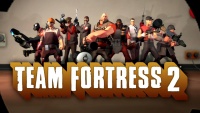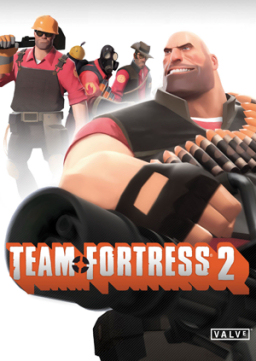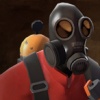Difference between revisions of "Team Fortress 2"
| Line 15: | Line 15: | ||
|URLTEXT=http://www.teamfortress.com/ | |URLTEXT=http://www.teamfortress.com/ | ||
}} | }} | ||
| − | '''Team Fortress 2''' is a first-person shooter for [[Wikipedia:Windows|Microsoft Windows]], [[Wikipedia:OSX|Mac OSX]], [[Wikipedia:Xbox|Xbox 360]], and [[Wikipedia:Playstation 3|Playstation 3]] created by [[Wikipedia:Valve|Valve Corporation]] using the [[Wikipedia:Source|Source]] game engine. Originally packaged as part of the ''Orange Box'', Team Fortress 2 became a standalone game on April 9, 2008. Fortress 2 then free-to-play on June 23, 2011 <ref> Team Fortress http://www.teamfortress.com</ref>. Presently, Team Fortress 2 is distributed online through the [[Wikipedia:Steam_(software)|Steam]] platform. The game was very well received, with scores of 92% on [[Wikipedia:Metacritic|Metacritic]]<ref>http://www.metacritic.com/game/pc/team-fortress-2</ref>, 95.8% on [[Wikipedia:GameRankings|GameRankings]]<ref>http://www.gamerankings.com/pc/437678-team-fortress-2/index.html</ref>, and an A on [[Wikipedia:1up.com|1UP]]<ref>http://www.1up.com/games/pc/team-fortress-2/</ref>. Trading scams, the use of physical currency to buy virtual goods, intellectual property, free software, and cheating are all ethical concerns involved with Fortress 2. | + | '''Team Fortress 2''' is a first-person shooter for [[Wikipedia:Windows|Microsoft Windows]], [[Wikipedia:OSX|Mac OSX]], [[Wikipedia:Xbox|Xbox 360]], and [[Wikipedia:Playstation 3|Playstation 3]] created by [[Wikipedia:Valve|Valve Corporation]] using the [[Wikipedia:Source|Source]] game engine. Originally packaged as part of the ''Orange Box'', Team Fortress 2 became a standalone game on April 9, 2008. Fortress 2 then free-to-play on June 23, 2011 <ref> Team Fortress http://www.teamfortress.com</ref>. Presently, Team Fortress 2 is distributed online through the [[Wikipedia:Steam_(software)|Steam]] platform. The game was very well received, with scores of 92% on [[Wikipedia:Metacritic|Metacritic]]<ref>http://www.metacritic.com/game/pc/team-fortress-2</ref>, 95.8% on [[Wikipedia:GameRankings|GameRankings]]<ref>http://www.gamerankings.com/pc/437678-team-fortress-2/index.html</ref>, and an A on [[Wikipedia:1up.com|1UP]]<ref>http://www.1up.com/games/pc/team-fortress-2/</ref>. Team Fortress 2 became one of the first major games, not including MMORPGSs, that was created as a multiplayer only game, and has greatly influenced the direction of the video game industry. Trading scams, the use of physical currency to buy virtual goods, intellectual property, free software, and cheating are all ethical concerns involved with Team Fortress 2. |
==Gameplay== | ==Gameplay== | ||
Revision as of 12:45, 26 March 2019
|
Team Fortress 2 is a first-person shooter for Microsoft Windows, Mac OSX, Xbox 360, and Playstation 3 created by Valve Corporation using the Source game engine. Originally packaged as part of the Orange Box, Team Fortress 2 became a standalone game on April 9, 2008. Fortress 2 then free-to-play on June 23, 2011 [1]. Presently, Team Fortress 2 is distributed online through the Steam platform. The game was very well received, with scores of 92% on Metacritic[2], 95.8% on GameRankings[3], and an A on 1UP[4]. Team Fortress 2 became one of the first major games, not including MMORPGSs, that was created as a multiplayer only game, and has greatly influenced the direction of the video game industry. Trading scams, the use of physical currency to buy virtual goods, intellectual property, free software, and cheating are all ethical concerns involved with Team Fortress 2.
Contents
Gameplay
In each match, there are two teams with the colors red and blue, respectively. The red team is Reliable Excavation & Demolition (RED) and the blue team is Builders League United (BLU). In each round of a match, RED and BLU team alternate between offense and defense. Unlike many multiplayer first-person shooter games, Team Fortress 2 does not natively support a "deathmatch"-type mode, where the only goal is to kill other players. Players are meant to cooperate to achieve objectives. The player gets to choose their class: Scout, Soldier, Pyro, Demoman, Heavy, Medic, Engineer, Spy, and Sniper. Each class has its place in the game; and, for example, the Medic heals all the other classes and builds ubercharge, an ability that when used, grants him and person he is healing invincibility for a short amount of time. The Soldier shoots rockets at the enemy for long-range combat and the Pyro has a flamethrower for close-range combat.
Classes
Maps and Game Modes
There are a variety of maps available to players, with some types being capture the flag, capture point, payload race, and arena, among others. Community-made maps are also available for players, and several of them have been added to the regular Valve map rotation. Maps can be purchased in the Mann Co. Store for local use, but can be played on for free if the server host owns them. Profits from both community-made maps and items in this fashion go to their creators.
Character customization
Characters can be customized with a number of different items, many of which are created by the community. They are well-documented on the Team Fortress 2 Wiki, and are often noted as one of the more well-known features of the game. Hats are primarily used as a point of humor, as hats and other miscellaneous items drive the game's economy, and most items can be translated into a measure of real-world wealth. These items are given out randomly to players through the extensively studied Drop System, with hats being amongst the rarest drops. The rarest of items can only be obtained by purchasing keys and opening crates, both items that can be purchased. Upon opening a crate, players have approximately a 1% chance of receiving an Unusual hat, which can range from being worth $20.00 USD to over $1000.00 USD.
History
Team Fortress 2's earliest predecessor is Team Fortress, a multiplayer mod based on the first-person shooter Quake that was designed by John Cook, Ian Coughley, and Robin Walker in 1996[5]. After the team was acquired by Valve Corporation in 1999, Team Fortress became Team Fortress Classic, which was a mod based on the Half-Life Software Development Kit[6]. "Team Fortress 2" was originally released as a part of the The Orange Box video game package. This original release was exclusively for Microsoft products, the Xbox 360 and Windows Operating System.[7] Two months later it was released for PlayStation 3. Given the success of the game, it was later released in 2008 as a standalone for Windows, and two years later for the Apple operating system Mac OS X. It was finally released on UNIX systems on November 6th, 2012. [8] Team Fortress 2 came as a big shock to many Team Fortress Classic players, as the art style was drastically different. With simple cartoon figures instead of dirty military figures, players approved of the new Team Fortress and it quickly grew in popularity [9].
Ethical Concerns
Trading Scams
With its bustling virtual economy, Team Fortress 2 is highly prone to trading scams. This most often happens to players who are trading for the first time or are just starting to get into trading. Because there are no set prices for items, players must estimate for themselves, look up what other people recommend, or ask a trusted trader for the prices. New players do not usually know these practices, and they get baited into what seems like a good deal when in actuality they would be losing a lot of value. Another common mistake is when players put too much trust in the other trader. For example, a trader might tell the player that he doesn't currently have the item that the players wants right now, but that he can get it later. The player trusts the trader, trades him the item, and subsequently never hears from the trader again. Trading scams bring up the topic of whether or not the developers or administrators of Team Fortress 2 are responsible for these online crimes since they have the authority to ban players and delete items. Currently, Team Fortress 2 does not take any responsibility for trade scammers. Instead, the responsibility goes to the administrators of various trade sites and forums (such as TF2Outpost [2] and TF2-Trader [3]) to ban scammers from returning to their sites. However, this does not stop trade scammers from using other sources to find victims.
Real Money for Virtual Goods
Trading with physical currency between players is neither encouraged nor discouraged by Valve. Valve maintains the Team Fortress 2 Mann Co. Store for purchasing in game items, which a relatively secure route for buying virtual goods, since the player must first put money in their Steam Wallet, then purchase items in-game using those funds. For many players, using real money to trade with other players takes out the middle step of buying Steam Wallet credit and selling/trading Mann Co. Store purchased items for the item that they want. Instead of two transactions, players only have to go through one by buying directly from other players. Since Valve has not taken a solid stance on this issue, players are put at a very high amount of risk when trading using real money because in every cash transaction, one player must go first, with the other following since there is no native support for this. Oftentimes, the player paying with real money will pay the trader with Paypal, the trader will confirm receiving the money, and then the trader will send the item to the player through the Steam trading system. This is different from the Valve-endorsed trading system, where both players enter a window, put their items for display, and confirm at the same time that they would like to do the trade. Trust is of utmost importance in situations using real money, and there are several sites dedicated to tracking a person's reputation. Paying real money for virtual goods is controversial in that there is mixing of a real economy with an online economy, and thus a mixing of laws. Determining the right course of action for rules and punishments is hazy. Often, Valve cannot take much legal action beyond banning a Steam account for dubious behavior.[10] There is also the question of whether virtual goods are worth physical currency or not, since loss of their items can occur at any moment through a hacker, a problem with the item database, or termination of the Team Fortress 2 game. Since they do not physically exist, their value can only be assessed by what those interested in it determine it to be worth.
Intellectual Property
When a player buys an item using real money, ownership of that item becomes ambiguous. One viewpoint is that the developers or the designers of the game primarily take ownership of the items. The other viewpoint is that users who acquired the item through a drop, trade, or real money have some claim of ownership. The concept of intellectual property is especially important when regarding physical currency. When using real money for trading, a sub-market is produced that includes players, virtual items, and physical currency. Because Valve has not placed any specific restrictions on trading with real money, the issue of using real economy laws to manage a virtual economy comes to play.
Cheating
As Team Fortress 2 is a Valve game, it is equipped with Valve's own anti-cheat system, Valve Anti-Cheat. It is a fully automated method of detecting cheaters on servers with VAC enabled. The purpose is to maintain a fair and balanced atmosphere within servers that choose to have VAC enabled. Any player caught by VAC will be banned from playing on any other servers secured with VAC[11]. Since the system is fully automated, it's questionable whether or not VAC is always correct in determining which users are cheating. However, Valve welcomes those that feel they have been wrongfully banned to contact their support team[12]. VAC works across several games on the Steam platform, threatening to subdue cheaters across a large scope, thus increasing the consequences of being caught cheating. With higher stakes, cheating is relatively subdued in Valve's games, Team Fortress 2 being a prime example.
Money Laundering
On November 11 2012, SteamRep user base64 made a post describing his detailed analysis which supported the conclusion that a group of people were using Team Fortress 2's in-game Mann Co. Store to purchase large quantities of items with stolen credit cards, transferring those items through several accounts, and selling them for real world profits through the procedure outlined above. [13] His analysis also determines that these items were being sold for Russian Rubles at a below-market price, acting in a way that doesn't make sense for someone acting as if they're using their own money. The conclusion is that Russian traders had used the Mann Co. Store to create a layer of protection between themselves and stolen credit card numbers, effectively laundering money through the Team Fortress 2 economy.
Violence in First-Person Shooters
As Team Fortress 2 allows a player to handle a variety of weapons from a first-person perspective, various arguments point to a body of evidence that violent video games contribute to desensitization and aggression. In a study involving college students, two groups played either violent video games or non-violent video games. Subsequently researchers placed participants in a scenario where a bystander was assaulted and in need of assistants, in which participants exposed to violent video games took 450% longer time to help the bystander. [14] With the nature of the violence depicted in Team Fortress 2, it is argued that engaging with weapons from a first-person perspective may raise concerns with current research.
See Also
External Links
References
- ↑ Team Fortress http://www.teamfortress.com
- ↑ http://www.metacritic.com/game/pc/team-fortress-2
- ↑ http://www.gamerankings.com/pc/437678-team-fortress-2/index.html
- ↑ http://www.1up.com/games/pc/team-fortress-2/
- ↑ http://en.wikipedia.org/wiki/Team_Fortress_2
- ↑ http://en.wikipedia.org/wiki/Team_Fortress_Classic
- ↑ http://www.planetfortress.com/tfc/guide/introduction.shtml
- ↑ http://www.gamespot.com/team-fortress-2/
- ↑ http://en.wikipedia.org/wiki/Team_Fortress_2
- ↑ https://support.steampowered.com/kb_article.php?ref=5406-WFZC-5519
- ↑ https://support.steampowered.com/kb_article.php?ref=7849-Radz-6869
- ↑ http://forums.steampowered.com/forums/showthread.php?t=1385172
- ↑ SteamRep Forums
- ↑ Shoot to Kill: The Real Impact of Violent Video Games, Bamford, Art, 28 July 2014 https://fulleryouthinstitute.org/blog/viamedia-shoot-to-kill










